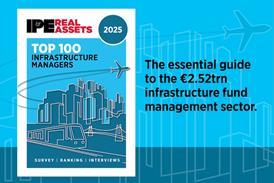Over the past several years, Europe’s commercial property investors have dragged themselves up a wall of worry as a plethora of risks and vulnerabilities in financial markets have threatened to undermine sentiment, writes Nicholas Spiro, partner at Lauressa Advisory.
Over the past several years, Europe’s commercial property investors have dragged themselves up a wall of worry as a plethora of risks and vulnerabilities in financial markets have threatened to undermine sentiment, writes Nicholas Spiro, partner at Lauressa Advisory.
To name a few, these mounting worries include the end of the US Federal Reserve’s quantitative easing (QE) programme, fears about China’s economy and concerns about the fallout from the collapse in oil prices.
Yet whenever market conditions deteriorated, the safety net provided by central banks’ ultra-loose monetary policies - the main plank of support for capital markets since the global financial crisis - helped mitigate fears about the global economy, desensitising investors to all sorts of risks and fuelling a surge in real estate transaction volumes which last year reached nearly €100 bn in the leading cities in Western Europe, double the figure in 2012, according to BNP Paribas Real Estate.
As we warned in an earlier column in the Financial Times last April, this liquidity-driven investment boom has led to an excessive compression in yields as investors moved up the risk curve, causing sentiment to become dangerously detached from underlying fundamentals in many markets.
However, as long as central banks’ actions - both actual and signalled - could be relied on to support (or, if truth be told, distort) asset prices and stabilise financial markets, thus encouraging risk-taking behaviour, most investors were willing to turn a blind eye to the disconnect between market values and fundamentals.
This confidence in central banks’ policies, which was misplaced in the first place, is now ebbing away.
For the first time since the eruption of the global financial crisis, central banks are increasingly perceived by investors as sources of volatility whose policies are not only proving ineffective but, as the recent furore over the impact of negative interest rates on banks’ earnings shows, counter-productive.
This palpable shift in sentiment - which in our view was the main reason behind the dramatic sell-off in equity markets earlier this year - puts Europe’s buoyant property investment market on a much less secure footing.
The central bank wedge that has been driven between asset prices and fundamentals has suddenly become thinner, making institutional investors more sensitive to economic and political developments across Europe.
While the underpinnings of Europe’s commercial real estate investment market - the 'weight of capital' targeting property, the conspicuous shortage of prime product in prime locations, the 'safe haven' appeal of the highly coveted London market and the recovery in occupational markets - remain in place, investment strategies must adapt to much more volatile financial conditions in 2016.
With monetary policy much less able to suppress risks in capital markets (and indeed now being faulted for amplifying them), Europe’s property investment landscape is becoming a lot more challenging.
Country-specific risks, as well as long-standing financial and economic vulnerabilities which have been suppressed by monetary stimulus, are now key determinants of sentiment.
The focal point of investor anxiety right now is the threat of a British exit from the European Union (EU), or 'Brexit', with a four-month-long run-up to a referendum on 23 June having already sparked fears of a currency crisis, with sterling trading at its lowest level against the dollar since 2009. While the uncertainties about the economic, legal and investment-related consequences of a Brexit are significant, so is the risk of contagion to the rest of the EU.
Even if the UK votes to remain in the EU - the likely outcome - the plebiscite has let the genie out of the bottle, fuelling anti-EU sentiment and encouraging other countries to hold referenda on a range of EU policies. Growing political tensions in the bloc are more likely to undermine investor confidence at a time when central banks are no longer able to stabilise financial markets.
Still, diminishing support from the world’s monetary guardians may be no bad thing if it disciplines Europe’s real estate investment market.
In the absence of a monetary safety blanket, investors are likely to become more discriminating. The fundamentals underpinning commercial property assets will come into sharper focus, leading to a reassessment of risk and valuations.
The much more challenging financial environment could also be the catalyst for a more thorough clean-up of the balance sheets of Europe’s banks whose stock of non-performing loans (NPLs) still amounts to a staggering €900 bn.
The wall of worry for Europe’s commercial real estate investors may have gotten higher - but the end of the so-called 'central bank put' could be a blessing in disguise.
Nicholas Spiro is a partner at Lauressa Advisory










